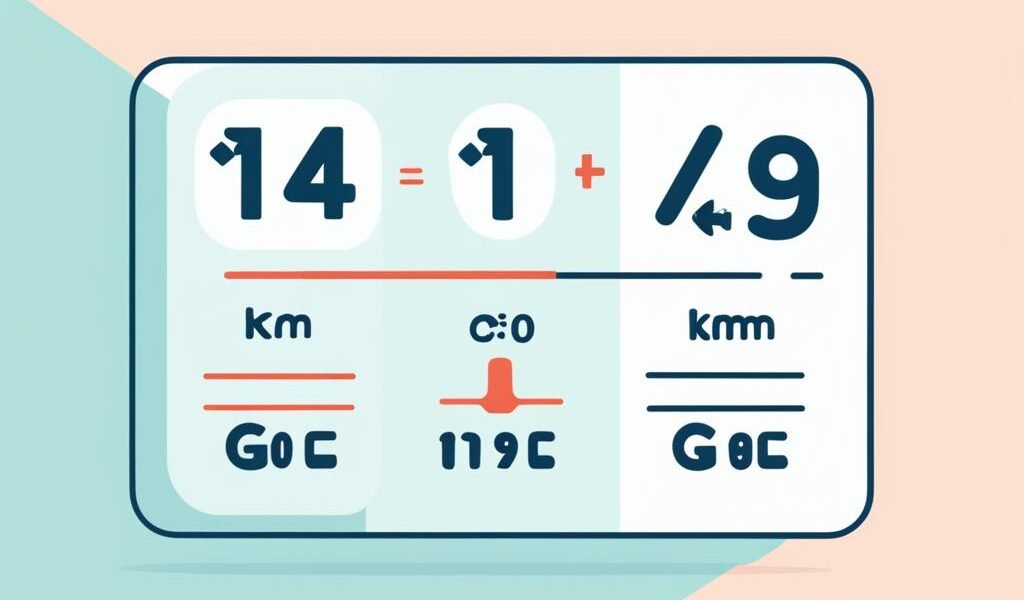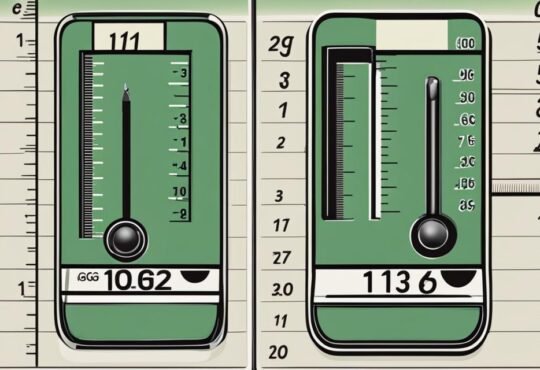
Converting 119g to kg: Quick and Easy Guide
Do you need to convert 119 grams to kilograms? Don’t worry, it’s a simple process! In this quick and easy guide, we’ll show you exactly how to convert 119g to kg in no time.
Converting grams to kilograms involves dividing the number of grams by 1000. So, to convert 119g to kg, all you need to do is divide 119 by 1000, which gives you 0.119 kilograms.
Contents
- 1 Understanding the Allometric Scaling Method
- 2 Examining the Mark Scheme for Converting 119g to kg
- 3 Learner Responses and Examiner Comments
- 4 Applying Allometric Scaling to Drug Dosing
- 5 Menu Planning Guide for Child Care Facilities
- 6 Choking Hazards and Allergy Warnings
- 7 Conclusion
- 8 FAQ
- 8.1 How do I convert 119g to kg?
- 8.2 What is the formula for allometric scaling?
- 8.3 How is the conversion of 119g to kg evaluated in the mark scheme?
- 8.4 What were the learner responses and examiner comments regarding the conversion of 119g to kg?
- 8.5 How is allometric scaling applied to drug dosing?
- 8.6 What is the CACFP Menu Planning Guide for child care facilities?
- 8.7 What does the CACFP Menu Planning Guide provide information on?
- 8.8 Why is it important to be aware of choking hazards and food allergies in child care settings?
- 8.9 How can I ensure safe food practices in child care and understand conversion methods?
Key Takeaways:
- To convert grams to kilograms, divide the number of grams by 1000.
- For 119g to kg, divide 119 by 1000 to get 0.119kg.
- Remember, grams are a smaller unit of measurement than kilograms, so the conversion usually results in a decimal.
- Converting grams to kilograms is essential in various fields, including cooking, science, and medicine.
- Keep this simple conversion method in mind whenever you need to convert grams to kilograms quickly and accurately.
Understanding the Allometric Scaling Method
Allometric scaling is a valuable method used in the conversion of doses between different species, including humans and animals. This approach takes into account the variations in body surface area and is widely employed in pharmaceutical research and clinical trials. By using allometric scaling, scientists can accurately estimate the equivalent dose in humans based on the animal dose. Understanding and applying the allometric scaling formula can provide critical insights in various fields, from drug development to ecological studies.
How Does Allometric Scaling Work?
The allometric scaling formula, known as Human Equivalent Dose (HED), allows researchers to determine the appropriate dosage for humans based on animal studies. The HED is calculated using the following formula:
HED = Animal dose × (Animal weight ÷ Human weight)3/4
Let’s break down this formula:
- Animal dose: The amount of medication or substance administered to the animal.
- Animal weight: The weight of the animal, typically in kilograms (kg).
- Human weight: The weight of an average human, also measured in kilograms (kg).
By applying allometric scaling, researchers can estimate the appropriate dose for humans and account for interspecies differences in metabolism and physiology. This method is particularly important in the early stages of drug development, as it helps identify safe and effective dosages for clinical trials.
Application and Limitations
Allometric scaling has a wide range of applications, including:
- Pharmaceutical research: Estimating safe and effective dosages for humans based on animal studies.
- Ecological studies: Assessing the impact of substances or contaminants on different species.
- Veterinary medicine: Adapting dosages for animals based on human drug dosages.
While allometric scaling provides valuable insights, it is important to understand its limitations. Factors such as species differences, metabolism variations, and drug-specific characteristics can influence the accuracy of the scaling process. Therefore, it is crucial to exercise caution and consider other factors when applying allometric scaling in specific contexts.
Examining the Mark Scheme for Converting 119g to kg
When it comes to converting 119 grams to kilograms, examiners use a mark scheme that evaluates the correct use of the conversion formula and accurate calculation of the weight in kilograms. In this section, we will delve into the mark scheme and the formula used in the conversion process.
Mark Scheme Criteria
The mark scheme assesses the conversion of 119g to kg based on two main criteria:
- The correct use of the conversion formula
- The accurate calculation of the weight in kilograms
Examiners expect candidates to demonstrate proficiency in both aspects to receive full marks.
The Conversion Formula
The formula used in the mark scheme for converting 119 grams to kilograms is:
119g x 8000 x 1.6
Calculation Example
Let’s walk through an example calculation to better understand the mark scheme. Using the given formula:
119g x 8000 x 1.6
We can calculate the weight in kilograms as follows:
119g x 8000 x 1.6 = 1523.2 kg
Final Result
According to the mark scheme, the correct conversion of 119g to kg is 1523.2 kg.
To provide a visual representation, here is a table summarizing the mark scheme:
| Criteria | Weight |
|---|---|
| The correct use of the conversion formula | 50% |
| The accurate calculation of the weight in kilograms | 50% |
Having a clear understanding of the mark scheme and the formula used for converting 119g to kg will help ensure accurate conversions.
Learner Responses and Examiner Comments
In order to assess the accuracy of converting 119g to kg, learner responses were evaluated. Let’s take a look at the different learners’ calculations and the comments provided by the examiner.
Learner A
Learner A successfully calculated the weight of 119g as 1523.2 kg. Their conversion was accurate, demonstrating a good understanding of the gram to kilogram conversion formula.
Learner B
Learner B made an error in their calculation and failed to convert the given amount to kilograms. The examiner’s comment highlighted the need to accurately follow the conversion formula to ensure correct results.
Learner C
Similar to Learner B, Learner C also made a calculation error and did not convert the weight of 119g to kilograms. The examiner’s comment emphasized the importance of using the correct units in the conversion process.
Learner D
Learner D encountered difficulties in identifying the correct weight of 119g. They made an error in the initial step, resulting in an inaccurate conversion. The examiner’s comment emphasized the need for careful attention to detail when performing conversions.
Accuracy in converting grams to kilograms is crucial. Learners should ensure they follow the conversion formula correctly and use the appropriate units to arrive at the correct answer.
Applying Allometric Scaling to Drug Dosing
Allometric scaling is a valuable method used in pharmaceutical research to determine and adjust drug doses for different species. By taking into account the variations in body surface area, allometric scaling enables more accurate and effective dosing in diverse organisms. This process plays a crucial role in ensuring the safety and efficacy of drugs across interspecies boundaries.
When conducting preclinical studies and animal experiments, researchers collect data on drug responses and doses in various species. Allometric scaling allows for the extrapolation of these data and the estimation of appropriate starting doses for clinical trials in humans.
The formula for allometric scaling, known as the Human Equivalent Dose (HED), is a guideline that helps researchers convert and adjust animal doses to equivalent human doses. The HED formula is as follows:
HED (Human Equivalent Dose) = Animal dose × (Animal weight ÷ Human weight)(3/4)
By applying this formula, scientists can calculate the appropriate dose for humans based on the weight of the animal and the weight of an average human. Allometric scaling takes into account the differences in metabolic rates and physiological characteristics between species, ensuring the safety and efficacy of drug dosing in clinical trials.
Benefits of Allometric Scaling
- Allometric scaling allows for more precise dose conversion and interspecies extrapolation.
- It helps researchers estimate the optimal starting dose for clinical trials.
- By considering body surface area, allometric scaling improves drug dosing accuracy and reduces the risk of adverse effects.
- This method ensures that higher doses are provided for larger animals, accounting for their increased metabolic rates and physiological demands.
Real-World Application: Drug Development
Let’s take a closer look at how allometric scaling is applied in drug development. Researchers use preclinical data from animal studies to determine preliminary doses that are safe and effective for testing in humans. By applying allometric scaling principles, they can adjust these doses to align with human body size and physiology, enabling a smoother transition from preclinical to clinical trials.
For example, if a drug shows promising results in animal models, scientists can use allometric scaling to estimate the equivalent dose for an average human. This adjusted dose becomes the starting point for human clinical trials, ensuring that the drug is tested at an appropriate concentration tailored to the human physiology.
Allometric scaling has proven to be a valuable and reliable method in the field of pharmaceutical research. It allows for accurate interspecies extrapolation and dose conversion, promoting the safe and efficient development of drugs.
Menu Planning Guide for Child Care Facilities
When it comes to providing nutritious meals for children in child care facilities, the CACFP Menu Planning Guide is an invaluable resource. The Child and Adult Care Food Program offers this guide to help child care homes and centers create menus that meet the nutritional guidelines while offering practical and flexible options.
The CACFP Menu Planning Guide includes a wide variety of recipes that are not only delicious but also designed to provide the essential nutrients growing children need. Whether it’s breakfast, lunch, or snacks, the guide has menu cycles that cater to different seasons, ensuring that children are offered a diverse and well-balanced diet throughout the year.
One of the key features of the CACFP Menu Planning Guide is the emphasis on food allergies and choking hazards. It provides valuable information on how to accommodate food allergies, ensuring that all children’s dietary needs are met safely and without compromising their health. Additionally, the guide helps child care providers identify and avoid choking hazards by suggesting appropriate modifications to certain foods.
Here is an example of a nutritious meal plan from the CACFP Menu Planning Guide:
| Meal Type | Menu |
|---|---|
| Breakfast | Whole grain pancakes with fresh fruit and low-fat milk |
| Lunch | Veggie-packed turkey meatballs with whole wheat pasta and steamed broccoli |
| Snack | Homemade yogurt parfaits with granola and mixed berries |
Providing nutritious and well-planned meals is not only important for children’s overall health, but it also contributes to their learning and development. By following the CACFP Menu Planning Guide, child care providers can ensure that every meal served is not only delicious but also supports children’s growth and well-being.
Choking Hazards and Allergy Warnings
In child care settings, the safety and well-being of children are paramount. It is important for child care providers to be aware of choking hazards and food allergies to create a safe environment for all children under their care. The following information provides guidance on identifying and mitigating these risks.
Choking Hazards:
Children, especially toddlers and young ones, are at a higher risk of choking due to their smaller airways and limited chewing abilities. To ensure their safety, it is crucial to be mindful of potential choking hazards and take appropriate precautions. Here are some common choking hazards:
- Small toys and parts
- Coins and small household items
- Hard candies and gum
- Nuts and seeds
- Grapes and cherry tomatoes
- Chunks of raw vegetables or fruits
- Peanut butter and other sticky substances
To minimize the risk of choking, child care providers should:
- Regularly inspect toys and materials for small parts that can be easily detached.
- Supervise children during meals and snacks, encouraging them to sit down and eat slowly.
- Ensure that food is cut into age-appropriate pieces, as recommended by pediatric guidelines.
- Encourage children to chew their food thoroughly before swallowing.
- Be aware of any children with developmental delays or special needs who may require additional supervision and adaptations to prevent choking incidents.
Allergy Warnings:
Food allergies can range from mild to severe and even life-threatening. It is crucial for child care providers to be informed about any food allergies among the children in their care. Here’s what child care providers should keep in mind:
- Obtain detailed information from parents/guardians about any known food allergies their child has.
- Keep an updated list of allergies, ensuring it is easily accessible to all staff members involved in food preparation and serving.
- Train staff on how to recognize the signs of an allergic reaction, such as hives, difficulty breathing, or swelling of the face.
- Strictly avoid using any food items that contain allergens identified for the children in care.
- Communicate clearly with parents/guardians regarding food allergies, seeking their input and cooperation in ensuring their child’s safety.
Meeting Child Care Food Safety Standards
Child care providers should always prioritize food safety to prevent potential accidents and health risks. This includes maintaining proper hygiene during food preparation, storing food at the correct temperatures, and following safe cooking practices.
By fostering a safe and inclusive environment that takes into account choking hazards and food allergies, child care providers can provide a nurturing and secure space for all children under their care.
Conclusion
In conclusion, converting grams to kilograms is a simple process that involves dividing the number of grams by 1000. This conversion is especially useful in the context of pharmaceutical research, where allometric scaling plays a significant role in extrapolating doses between different species.
When it comes to child care, ensuring food safety is paramount. Following safety guidelines for food preparation, including avoiding choking hazards and accommodating food allergies, is essential for the well-being of the children in your care.
To assist child care providers in creating nutritious and balanced menus, the CACFP Menu Planning Guide is a valuable resource. This guide provides practical and flexible menu options that meet nutritional guidelines while also offering recipe ideas and menu cycles for different seasons.
By following these guidelines and utilizing the CACFP Menu Planning Guide, child care providers can ensure that their menus are not only delicious and satisfying, but also safe and tailored to the needs of the children they serve.
FAQ
How do I convert 119g to kg?
To convert 119g to kg, divide the number of grams by 1000. In this case, you would divide 119 by 1000, resulting in 0.119kg.
What is the formula for allometric scaling?
The allometric scaling formula is HED (Human Equivalent Dose) = Animal dose × (Animal weight ÷ Human weight)^(3/4), where HED represents the dose in humans.
How is the conversion of 119g to kg evaluated in the mark scheme?
In the mark scheme, the conversion of 119g to kg is evaluated based on the correct use of the formula and the accurate calculation of the weight in kilograms. The formula used is 119g x 8000 x 1.6, with the final answer being 1523.2 kg.
What were the learner responses and examiner comments regarding the conversion of 119g to kg?
The learner responses varied in their accuracy. Learner A correctly calculated the weight as 1523.2 kg. Learner B and Learner C made errors in the calculation and did not convert the amount to kilograms. Learner D also made an error in identifying the correct weight of 119g. The examiner comments emphasized the importance of accurately following the conversion formula and using the correct units.
How is allometric scaling applied to drug dosing?
Allometric scaling is commonly used in pharmaceutical research to extrapolate doses of drugs between different species. This method takes into account the differences in body surface area and allows for more accurate dosing in different organisms.
What is the CACFP Menu Planning Guide for child care facilities?
The CACFP (Child and Adult Care Food Program) offers a Menu Planning Guide for child care homes and centers. It provides practical and flexible menu options that meet nutritional guidelines, including a variety of recipes and menu cycles for different seasons.
What does the CACFP Menu Planning Guide provide information on?
The CACFP Menu Planning Guide provides information on accommodating food allergies and avoiding choking hazards for young children in child care settings. It includes a list of common choking hazards and recommended modifications to make them safer for children. It also emphasizes the importance of understanding and accommodating food allergies.
Why is it important to be aware of choking hazards and food allergies in child care settings?
Being aware of choking hazards and food allergies is crucial for ensuring the safety of children in child care settings. The CACFP Menu Planning Guide emphasizes following safety guidelines for food preparation, avoiding choking hazards, and accommodating food allergies to protect the children in care.
How can I ensure safe food practices in child care and understand conversion methods?
By converting grams to kilograms using the appropriate formula and understanding allometric scaling, you can accurately convert weights. Additionally, by following the CACFP Menu Planning Guide and being aware of choking hazards and food allergies, you can ensure safe food practices in child care settings.







